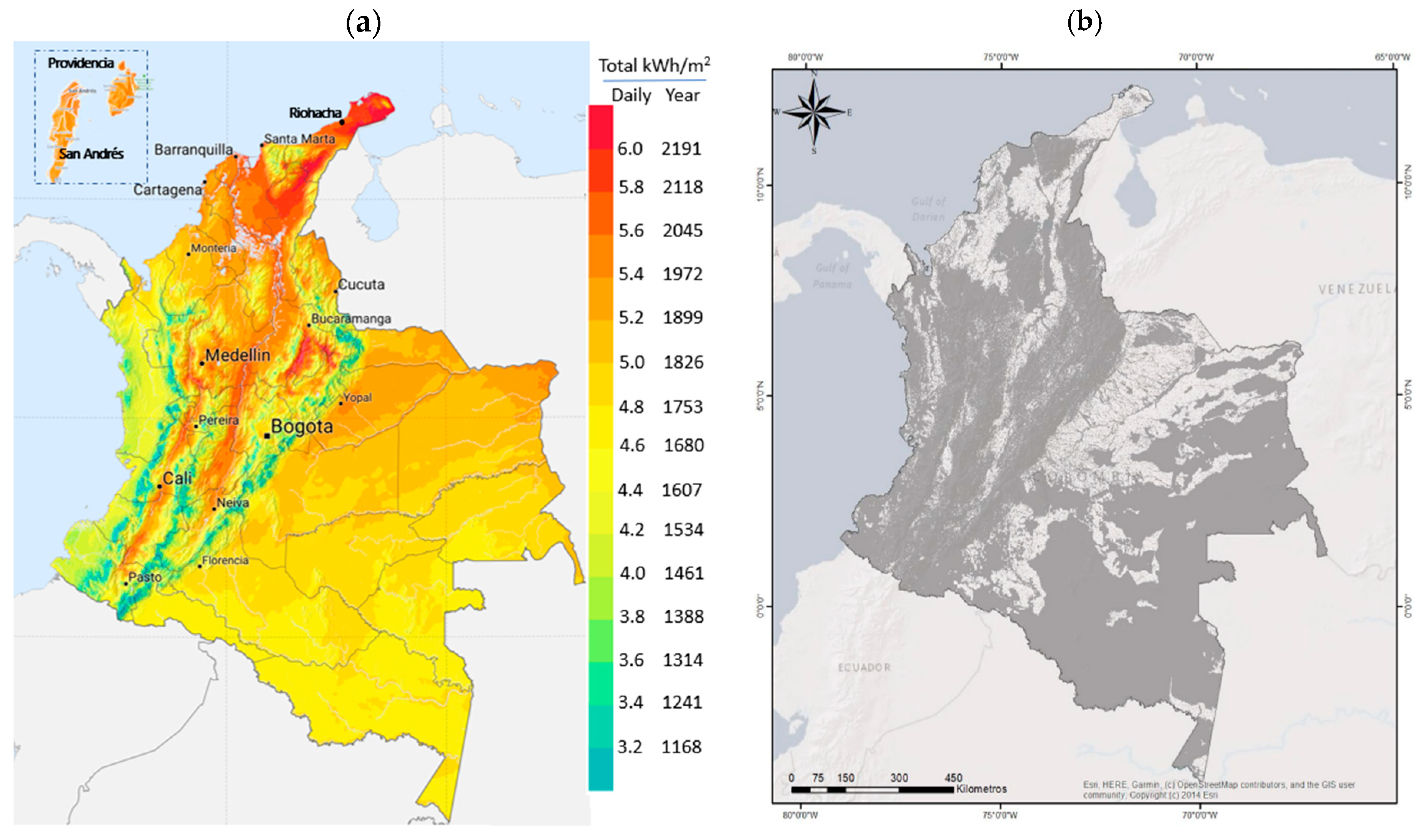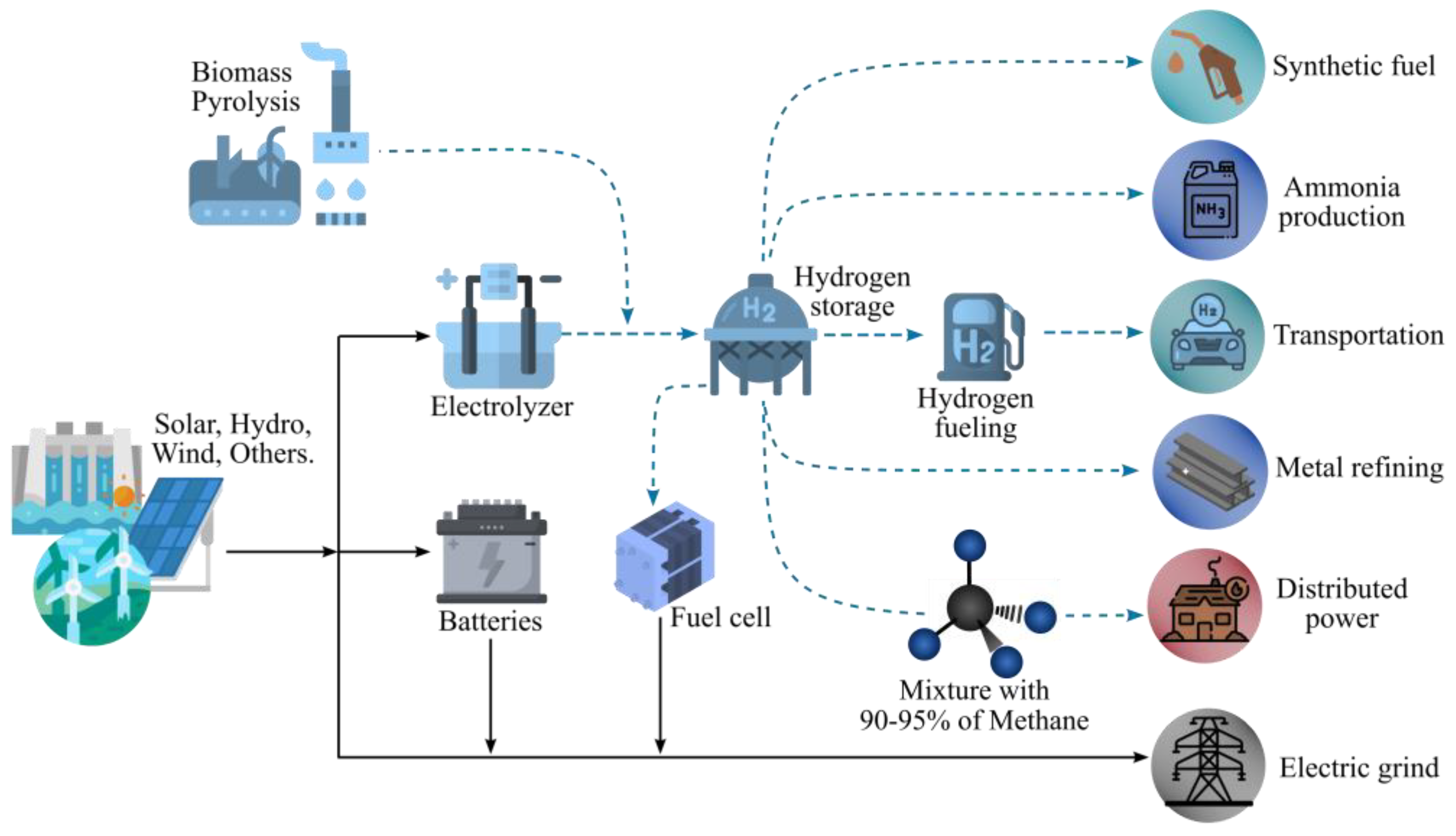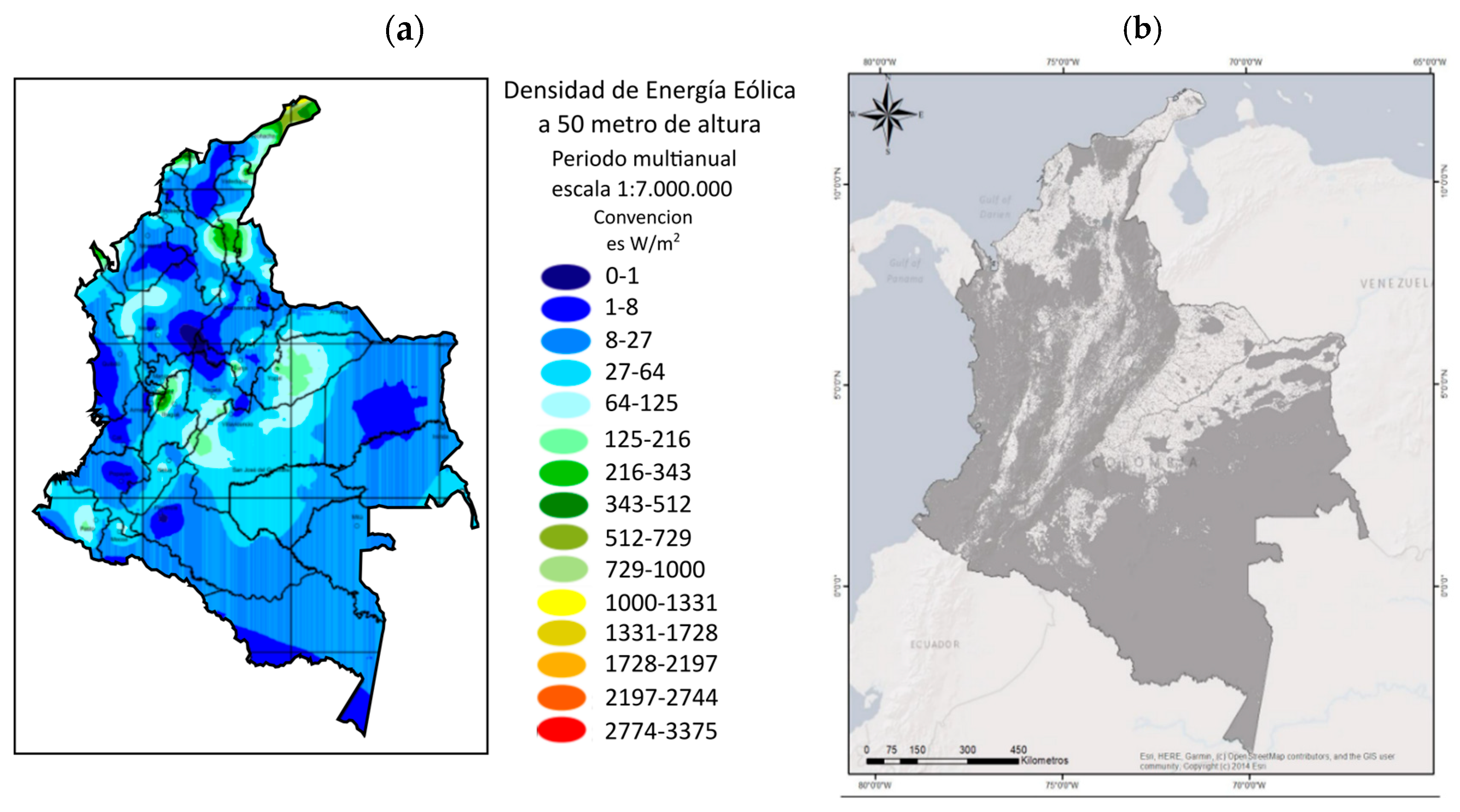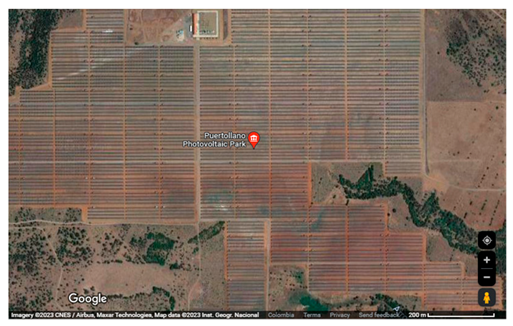Renewable Energy Sources for Green Hydrogen Generation in Colombia and Applicable Case of Studies
Abstract
1. Introduction
- “The hydrogen produced by splitting water into hydrogen and oxygen using renewable electricity”;
- “Green hydrogen projects operate with less than 4.37 kg CO2eq per kg H2”.
2. Solar Power for Green H2 Generation
2.1. Solar Potential in Colombia
- Physical: wetlands, slopes, available area, etc.
- Biotic: protected areas, ecosystems, etc.
- Economic: distance to roads, electricity grid and urban areas, etc.
- Cultural: archaeological zones and ethnic territories.
- Political: post-conflict zones.

2.2. Case Study: Solar for Green H2 Generation
- Encouraging financial support and initial investment: The establishment of solar parks requires substantial initial investment and financing that can be leveraged with foreign or mixed public–private investment.
- Land use: Although Colombia has regions of high solar radiation potential, the regulation and facilitation of land use for solar PV projects limits their implementation due to protected areas and regions with restricted access due to violence.
- Boosting research and technological development: Research and technological development is essential to reduce Colombia’s dependence on foreign countries for the production of solar panels, inverters, regulators and other critical components needed for PV installations.
- Expanding the grid: An imperative challenge is to expand the grid to accommodate the integration of solar energy and ensure its effective distribution.
3. Hydropower for Green H2 Generation
- -
- Environmental: affectation of forest and wildlife habitat.
- -
- Social: human forced displacement, arbitrary decision on water usage and loss of patrimonial lands.
- -
- Economic: loss of agriculture lands and high start-up costs.
3.1. Hydropower Potential in Colombia
3.2. Case Study: Hydropower for Green H2 Generation
4. Wind Power for Green H2 Generation
4.1. Wind Potential in Colombia
4.2. Case Study: Wind for Green H2 Generation
5. Biomass for Green H2 Generation
- -
- Environmental: deforestation, biodiversity loss and land degradation. Basically, encouraging its production is controversial, since it implies generating more waste leading to the depletion of valuable resources such as water, soil and fertilizers. In addition, biomass processing and its usage generate greenhouse gas emissions such as CO2 during direct combustion and methane when biomass is transformed into biogas. The biogas resulting from the anaerobic fermentation of biomass contains a mixture of methane (55–65%), CO2 (30–45%) and traces of H2S and water. All efforts to prevent methane reaching the atmosphere are justified, since its warming potential is 25 times that of CO2 [74].
- -
- Social: biomass as an energy source can compete with food production, leading to social conflicts.
- -
- Legal: regulatory barriers associated with the lack of standardization.
- -
- Technical: the solution is not scalable. It is limited by the availability of high-quality biomass (the biomass leading to high conversion efficiencies).
5.1. Biomass Potential in Colombia
5.2. Case Study: Biogas for Green H2 Generation
6. Other Energies for Green H2 Generation in Colombia
7. General Overview
8. Conclusions
Author Contributions
Funding
Data Availability Statement
Conflicts of Interest
References
- Jaramillo, C.; Escobar, L. Proyección de Demanda de Energéticos; Unidad de Planeación Minero Energética (UPME): Bogotá, Colombia, 2022. [Google Scholar]
- Ritchie, H.; Roser, M. Energy. Available online: https://ourworldindata.org/energy (accessed on 5 November 2022).
- Escobar, F.A. 1992: El año del Apagón. Available online: https://www.senalmemoria.co/articulos/apagon-ano-1992 (accessed on 30 October 2022).
- US Department of Energy. H2@Scale. Available online: https://www.energy.gov/eere/fuelcells/h2scale (accessed on 12 October 2022).
- International Energy Agency. The Future of Hydrogen: Seizing Today’s Opportunities. Available online: https://www.iea.org/reports/the-future-of-hydrogen (accessed on 12 October 2022).
- Ágel, M.; Botet, C.; Cuello, N.; Laverde, M. Recomendaciones Para el Desarrollo de la Economía del Hidrógeno en Colombia: Una Estrategia Nacional de Hidrógeno; Primera, Ed.; Universidad de La Sabana: Chía, Colombia, 2022. [Google Scholar]
- World Energy Council. National Hydrogen Strategies. Available online: https://www.worldenergy.org/assets/downloads/Working_Paper_-_National_Hydrogen_Strategies_-_September_2021.pdf (accessed on 10 October 2022).
- Ministerio de Minas y Energía. Decreto 1476; Ministerio de Minas y Energía: Bogotá, Colombia, 2022. [Google Scholar]
- Actualización del Costo Nivelado de Energía (LCOE) Para 1er Semestre de 2021. Available online: https://www.bloomberg.com/latam/blog/actualizacion-del-costo-nivelado-de-energia-lcoe-para-1er-semestre-de-2021/ (accessed on 12 October 2022).
- Shahabuddin, M.; Krishna, M.M.; Bhaskar, T.; Perkins, G. Advances in the thermo-chemical production of hydrogen from biomass and residual wastes: Summary of recent techno-economic analyses. Bioresour. Technol. 2020, 299, 122–557. [Google Scholar] [CrossRef] [PubMed]
- Reed, J. UC Office of the President Can Green Hydrogen Be a Cost Competitive Transportation Fuel by 2030? Calif. Digit. Libr. Univ. Calif. 2022, 1, 1–5. [Google Scholar] [CrossRef]
- Micena, R.P.; Llerena, O.R.; De Souza, T.M.; Silveira, J.L. Solar-powered Hydrogen Refueling Stations: A techno-economic analysis. Int. J. Hydrogen Energy 2020, 45, 2308–2318. [Google Scholar] [CrossRef]
- The World Bank. What a Waste 2.0. Available online: https://datatopics.worldbank.org/what-a-waste/ (accessed on 10 November 2022).
- Abbott, D. Keeping the energy debate clean: How do we supply the world’s energy needs? Proc. IEEE 2010, 98, 42–66. [Google Scholar] [CrossRef]
- World Bank Group. Global Solar Atlas. Available online: https://globalsolaratlas.info/map?c=10.943357,16.233488,3 (accessed on 25 October 2022).
- Rodríguez, D.; Rodríguez, L. Photovoltaic energy in Colombia: Current status, inventory, policies and future prospects. Renew. Sustain. Energy Rev. 2018, 92, 160–170. [Google Scholar] [CrossRef]
- IRENA; USAID. Renewable Energy Auctions in Colombia: Context, Design and Results; International Renewable Energy Agency: Abu Dhabi, United Arab Emirates, 2021. [Google Scholar]
- Congreso de Colombia. Ley 1715 de 2014; Departamento Administrativo de la Función Pública: Bogotá, Colombia, 2014. [Google Scholar]
- Urrego, A. En Los Próximos Tres Años, 10 Empresas Podrán en Operación Nuevas Granjas Solares. Available online: https://www.larepublica.co/empresas/en-los-proximos-dos-anos-10-empresas-podran-en-operacion-nuevas-granjas-solares-3346288 (accessed on 15 October 2022).
- Ministerio de Minas y Energía. Transición Energética: Un Legado Para el Presente y el Futuro de Colombia. Available online: www.laimprentaeditores.com (accessed on 1 November 2022).
- Ministerio de Minas y Energía. Diálogo Social Para Definir la Hoja de Ruta Para la Transición Energética Justa en Colombia. Available online: https://bit.ly/HojaRutaTransicionEnergeticaJustaCO (accessed on 1 October 2022).
- Kim, J.H.; Hansora, D.; Sharma, P.; Jang, J.W.; Lee, J.S. Toward practical solar hydrogen production—An artificial photosynthetic leaf-to-farm challenge. Chem. Soc. Rev. 2019, 48, 1908–1971. [Google Scholar] [CrossRef]
- Wang, Q.; Domen, K. Particulate Photocatalysts for Light-Driven Water Splitting: Mechanisms, Challenges, and Design Strategies. Chem. Rev. 2020, 120, 919–985. [Google Scholar] [CrossRef]
- Luo, S.; Ren, X.; Lin, H.; Song, H.; Ye, J. Plasmonic photothermal catalysis for solar-to-fuel conversion: Current status and prospects. Chem. Sci. 2021, 12, 5701–5719. [Google Scholar] [CrossRef]
- Sharma, A.; Arya, S.K. Hydrogen from algal biomass: A review of production process. Biotechnol. Rep. 2017, 15, 63–69. [Google Scholar] [CrossRef]
- Pregger, T.; Graf, D.; Krewitt, W.; Sattler, C.; Roeb, M.; Möller, S. Prospects of solar thermal hydrogen production processes. Int. J. Hydrogen Energy 2009, 34, 4256–4267. [Google Scholar] [CrossRef]
- Hisatomi, T.; Domen, K. Reaction systems for solar hydrogen production via water splitting with particulate semiconductor photocatalysts. Nat. Catal. 2019, 2, 387–399. [Google Scholar] [CrossRef]
- Grimm, A.; De Jong, W.A.; Kramer, G.J. Renewable hydrogen production: A techno-economic comparison of photoelectrochemical cells and photovoltaic-electrolysis. Int. J. Hydrogen Energy 2020, 45, 22545–22555. [Google Scholar] [CrossRef]
- Polman, A.; Knight, M.; Garnett, E.C.; Ehrler, B.; Sinke, W.C. Photovoltaic materials: Present efficiencies and future challenges. Science 2016, 352, aad4424. [Google Scholar] [CrossRef] [PubMed]
- Eljack, F.; Kazi, M.K. Prospects and Challenges of Green Hydrogen Economy via Multi-Sector Global Symbiosis in Qatar. Front. Sustain. 2020, 1, 612762. [Google Scholar] [CrossRef]
- Ariza, M.F.; Mwanza, M.; Çetin, N.S.; Ülgen, K. Assessment of the energy generation potential of photovoltaic systems in Caribbean region of Colombia. Period. Eng. Nat. Sci. 2017, 5, 55–60. [Google Scholar] [CrossRef][Green Version]
- Orrego, S.G. Análisis Espacial Multicriterio Para la Ubicación de Parques Eólicos y Granjas Solares en Colombia. Available online: https://repositorio.unal.edu.co/handle/unal/79490 (accessed on 29 September 2022).
- Romero, I.; Franco, B. La oportunidad de negocio de la Generación Solar Distribuida en Colombia; Generación Sole; Programa de las Naciones Unidas para el Medio Ambiente (PNUMA): Clayton, Panama, 2021; pp. 1–180. Available online: https://ser-colombia.org/wp-content/uploads/2021/11/Generacio%CC%81n-Sole-Financiamiento-GDS-Col.pdf (accessed on 29 September 2022).
- DANE. ¿Dónde Estamos? Available online: https://www.dane.gov.co/index.php/estadisticas-por-tema/demografia-y-poblacion/censo-nacional-de-poblacion-y-vivenda-2018/donde-estamos (accessed on 3 October 2022).
- Sireagroup. Green Hydrogen: With Photovoltaics, We Will Produce Our Own Hydrogen. Available online: https://www.sireagroup.com/en/2021/03/22/green-hydrogen-photovoltaics/ (accessed on 3 October 2022).
- Meneses, E. Chile Produce su Primera Molécula de Hidrógeno Verde Para Minería. Available online: https://www.rumbominero.com/peru/noticias/internacionales/chile-produce-su-primera-molecula-de-hidrogeno-verde-para-mineria/ (accessed on 4 October 2022).
- Collins, L. Shanghai Goes All-in on Hydrogen, with Plans for H2 Port, Pipelines and Trading Platform. Available online: https://www.rechargenews.com/energy-transition/shanghai-goes-all-in-on-hydrogen-with-plans-for-h2-port-pipelines-and-trading-platform/2-1-1288034 (accessed on 10 October 2022).
- Pinedo, E.; Carreño, B. France, Spain and Portugal Agree to Build Barcelona-Marseille Gas Pipeline. Available online: https://www.reuters.com/business/energy/spain-france-portugal-agree-new-energy-route-pm-sanchez-says-2022-10-20/ (accessed on 4 November 2022).
- IBERDROLA. Iberdrola Instala la Mayor Planta de Hidrógeno Verde Para Uso Industrial en Europa. Available online: https://www.iberdrola.com/conocenos/nuestra-actividad/hidrogeno-verde/puertollano-planta-hidrogeno-verde (accessed on 6 November 2022).
- El digital CLM. Castilla-La Mancha es la Comunidad con Más Energía Fotovoltaica Instalada en 2022. Available online: https://www.elespanol.com/eldigitalcastillalamancha/region/20220519/castilla-la-mancha-comunidad-energia-fotovoltaica-instalada/673683125_0.html (accessed on 6 November 2022).
- World Energy Trade. Iberdrola Abre la Mayor Planta de Hidrógeno Verde de Europa Dirigida al Sector Industrial. Available online: https://www.worldenergytrade.com/energias-alternativas/gas/iberdrola-mayor-planta-hidrogeno-verde-europa (accessed on 6 November 2022).
- Jaganmohan, M. Cumulative Hydropower Capacity Worldwide in 2021, by Major Country. Available online: https://www.statista.com/statistics/474652/global-total-hydropower-capacity-in-major-countries/#statisticContainer (accessed on 25 October 2022).
- IHA. Hydropower Status Report 2022. Available online: https://www.hydropower.org/sites/default/files/publications-docs/2019_hydropower_status_report_0.pdf (accessed on 2 November 2022).
- IRENA. Renewable Power Generation Costs in 2014: Hydropower 2010. IRENA, 2014; Volume 1, pp. 113–123. Available online: https://www.irena.org/-/media/Files/IRENA/Agency/Publication/2015/IRENA_RE_Power_Costs_2014_report.pdf (accessed on 2 November 2022).
- IEA. Hydrogen. Available online: https://www.iea.org/reports/hydrogen (accessed on 2 November 2022).
- IHA. The Green Hydrogen Revolution: Hydropower’s Transformative Role. IHA, 2021; Volume 1, no. May. pp. 1–8. Available online: https://www.hydropower.org/publications/the-green-hydrogen-revolution-hydropowers-transformative-role (accessed on 3 November 2022).
- Cano, S.L. Challenges for a Just Energy Transition in Andean Economies. l’université Sorbonne Nouvelle. Master’s Thesis. 2021, pp. 1–155. Available online: https://dumas.ccsd.cnrs.fr/dumas-04136491/document (accessed on 3 November 2022).
- UPME. Evaluación del Potencial Hidroenergético a Pequeña Escala en Cuencas Hidrológicas con un Modelo Lluvia-Escurrimiento: Capítulo 4 EVALUACIÓN DEL POTENCIAL HIDROENERGÉTICO; Central Urrá: Cordoba, Colombia, 2015; pp. 73–110. [Google Scholar]
- Esri. ArcGIS Online. Available online: https://www.arcgis.com/home/webmap/viewer.html?url=https://geo.upme.gov.co/server/rest/services/UPME_PE/Potencial_Hidroenerg%25C3%25A9tico_por_subzona_hidrogr%25C3%25A1fica_Lc_1_kil%25C3%25B3metro/FeatureServer&source=sd (accessed on 30 October 2022).
- Posso, F.; Espinoza, J.L.; Sánchez, J.; Zalamea, J. Hydrogen from hydropower in Ecuador: Use and impacts in the transport sector. Int. J. Hydrogen Energy 2015, 40, 15432–15447. [Google Scholar] [CrossRef]
- Thapa, B.S.; Neupane, B.; Seong, H.; Lee, Y.H. Green hydrogen potentials from surplus hydro energy in Nepal. Int. J. Hydrogen Energy 2021, 46, 22256–22267. [Google Scholar] [CrossRef]
- IEA. Hydrogen Projects Database. Available online: https://www.iea.org/data-and-statistics/data-product/hydrogen-projects-database (accessed on 30 October 2022).
- FuelCellsWorks. Air Liquide and Cummins Go All-In on Green Hydrogen. FuelCellsWorks, 2020. Available online: https://fuelcellsworks.com/news/air-liquide-and-cummins-go-all-in-on-green-hydrogen/ (accessed on 30 October 2022).
- Edwardes-Evans, H. Air Liquide Completes 20 MW Canadian Electrolysis Plant. Available online: https://www.spglobal.com/commodityinsights/en/market-insights/latest-news/electric-power/012621-air-liquide-completes-20-mw-canadian-electrolysis-plant (accessed on 15 October 2022).
- Air Liquide. Air Liquide Inaugurates the World’s Largest Low-Carbon Hydrogen Membrane-Based Production Unit in Canada. Available online: https://www.airliquide.com/group/press-releases-news/2021-01-26/air-liquide-inaugurates-worlds-largest-low-carbon-hydrogen-membrane-based-production-unit-canada (accessed on 15 October 2022).
- Bécancour PEM Green Hydrogen Plant; Nomination for ACEC Award: Project Management Category; Ais Liquide: Bécancour, QC, Canada; Hatch: Mississauga, ON, Canada, 2021; pp. 1–7.
- cummins.com. Cummins HyLYZER-1000 Water Electrolysis Specification Sheet. Available online: https://www.cummins.com/sites/default/files/2021-08/cummins-hylyzer-1000-specsheet.pdf (accessed on 17 October 2022).
- Canadian Hydropower Association. Canadian Hydro Capacity and Potential (MW). Available online: https://canadahydro.ca/wp-content/uploads/2015/09/CHA-map-Capacity-Potential-2015-v6.pdf (accessed on 17 October 2022).
- Abu, D. Renewable Power Generation Costs in 2020; IRENA: Abu Dhabi, United Arab Emirates, 2021. [Google Scholar]
- IRENA. Wind Energy. Available online: https://www.irena.org/Energy-Transition/Technology/Wind-energy (accessed on 3 November 2022).
- Fang, R.; Liang, Y. Control strategy of electrolyzer in a wind-hydrogen system considering the constraints of switching times. Int. J. Hydrogen Energy 2019, 44, 25104–25111. [Google Scholar] [CrossRef]
- Mikovits, C.; Wetterlund, E.; Wehrle, S.; Baumgartner, J.; Schmidt, J. Stronger together: Multi-annual variability of hydrogen production supported by wind power in Sweden. Appl. Energy 2021, 282, 116082. [Google Scholar] [CrossRef]
- McKenna, R.C.; Bchini, Q.; Weinand, J.M.; Michaelis, J.; König, S.; Köppel, W.; Fichtner, W. The future role of Power-to-Gas in the energy transition: Regional and local techno-economic analyses in Baden-Württemberg. Appl. Energy 2018, 212, 386–400. [Google Scholar] [CrossRef]
- EPM. Parque Eólico Jepírachi. Available online: https://www.epm.com.co/site/home/nuestra-empresa/nuestras-plantas/energia/parque-eolico (accessed on 3 November 2022).
- Urrego, A. Gobierno inauguró Guajira 1, el primer parque eólico que aportará 20 MW de energía. Available online: https://www.larepublica.co/economia/gobierno-inaugurara-hoy-el-parque-eolico-guajira-1-el-mas-grande-de-colombia-3289884 (accessed on 3 November 2022).
- Buljan, A. Colombia Opens Up for Offshore Wind, CIP Enters with 350 MW Project. Available online: https://www.offshorewind.biz/2022/03/08/colombia-opens-up-for-offshore-wind-cip-enters-with-350-mw-project/ (accessed on 4 November 2022).
- Ministerio de Minas y Energía. Atlas del Viento y Energía Eólica; Ministerio de Minas y Energía: Bogotá, Colombia, 2006; Chapter 4; pp. 75–102. ISBN 9588067170. [Google Scholar]
- Memija, A. Shell to Start Building Europe’s Largest Offshore Wind-to-Hydrogen Plant in Netherlands (Video). Available online: https://www.offshorewind.biz/2022/07/06/shell-to-start-building-europes-largest-offshore-wind-to-hydrogen-plant-in-netherlands-video/ (accessed on 4 November 2022).
- Port of Rotterdam. Rotterdam Offshore Wind Coalition. Available online: https://www.portofrotterdam.com/en/setting/location-options/offshore/rotterdam-offshore-wind-coalition (accessed on 5 November 2022).
- REUTERS. Shell to Start Construction of Renewable Hydrogen Plant in Netherlands. Available online: https://www.reuters.com/business/energy/shell-start-construction-renewable-hydrogen-plant-netherlands-2022-07-06/ (accessed on 5 November 2022).
- Shell Global. Shell to Start Building Europe’s Largest Renewable Hydrogen Plant. Available online: https://www.shell.com/media/news-and-media-releases/2022/shell-to-start-building-europes-largest-renewable-hydrogen-plant.html (accessed on 5 November 2022).
- Aparicio, I.; Eecen, P.; Telsnig, T.; Vazquez, C. Annual progress report on SET-Plan offshore wind. Deliverable 2020, 1, 1–34. [Google Scholar]
- World Bank Group; ESMAP; VORTEX; DTU. Global Wind Atlas. Available online: https://globalwindatlas.info/en/area/Netherlands (accessed on 5 November 2022).
- EPA. Importance of Methane. Available online: https://www.epa.gov/gmi/importance-methane (accessed on 4 November 2022).
- Milne, T.; Elam, C.; Evans, R. Hydrogen from Biomass State of the Art and Research Challenges; International Energy Agency Agreement on the Production and Utilization of Hydrogen; National Renewable Energy Lab. (NREL): Golden, CO, USA, 2002. [Google Scholar]
- U.S. Departament of Energy. Hydrogen Production: Photobiological. Available online: https://www.energy.gov/eere/fuelcells/hydrogen-production-photobiological (accessed on 4 November 2022).
- Nationalgrid. The Hydrogen Colour Spectrum. Available online: https://www.nationalgrid.com/stories/energy-explained/hydrogen-colour-spectrum (accessed on 4 November 2022).
- Brandon, N.P.; Kurban, Z. Clean energy and the hydrogen economy. Philosophical Transactions of the Royal Society a Mathematical. Phys. Eng. Sci. 2017, 17, 20160400. [Google Scholar] [CrossRef]
- EQTEC. How Biomass Gasification can Help Boost Global Green Hydrogen Production. Available online: https://eqtec.com/how-biomass-gasification-can-help-boost-global-green-hydrogen-production/ (accessed on 4 November 2022).
- González, T.; Valencia, J.; UPME. Integración de las Energías Renovables no Convencionales en Colombia; UPME: Bogotá, Colombia, 2015. [Google Scholar]
- Esri. ArcGis. Available online: https://www.arcgis.com/home/webmap/viewer.html?url=https://geo.upme.gov.co/server/rest/services/BIOMASA/Potencial_total_nacional_tj_A%25C3%25B1o/MapServer&source=sd (accessed on 4 November 2022).
- C|Zero. Decarbonizing Natural Gas. Available online: https://www.czero.energy/ (accessed on 5 November 2022).
- Pure Hydrogen “Pure Hydrogen”. Available online: https://purehydrogen.com.au/news/ (accessed on 8 November 2022).
- Raaijen, W. HYTE: Pilot plant turquoise hydrogen at BASF in Ludwigshafen. Available online: https://www.industryandenergy.eu/hydrogen/hyte-pilot-plant-turquoise-hydrogen-at-basf-in-ludwigshafen/ (accessed on 8 November 2022).
- Ball, D.P. Cutting-Edge Hydrogen Power Project Planned for Port Moody Social Sharing. Available online: https://www.cbc.ca/news/canada/british-columbia/hydrogen-power-project-pilot-port-moody-bc-1.6510422 (accessed on 8 November 2022).
- ARENA. The Hazer Process: Commercial Demonstration Plant. Available online: https://arena.gov.au/projects/the-hazer-process-commercial-demonstration-plant/ (accessed on 8 November 2022).
- Urade, A. Integrating Sustainability into Graphene Nanomaterial Synthesis. Available online: https://www.azonano.com/article.aspx?ArticleID=6181 (accessed on 10 November 2022).
- Graphene Manufacturing Grup. Aluminium-Ion Battery. Available online: https://graphenemg.com/energy-storage-solutions/aluminum-ion-battery/ (accessed on 10 November 2022).
- Hazer Group Ltd ASX:HZR. 2021, pp. 1–16. Available online: https://www.ammoniaenergy.org/wp-content/uploads/2021/05/210316-Hazer-Group-LImited-ASX-Small-Caps-Conference-GW-Rev-11.pdf (accessed on 10 November 2022).
- Williamson, D.; Christie, I. Argonaut Report—Initiation—Cracking the Code. Available online: https://hazergroup.com.au/research-reports/ (accessed on 10 November 2022).
- Harris, C. Water Corporation Fuelling an Australian-First Hydrogen Project. Available online: https://www.awa.asn.au/resources/latest-news/technology/innovation/water-corporation-fuelling-an-australian-first-hydrogen-project (accessed on 11 November 2022).
- Alfaro, C.; Rueda, J.; Casallas, Y.; Rodriguez, G.; Malo, J. Proyecto Investigación Geotérmica de Colombia; Minenergía: Bogota, Colombia, 2020; pp. 1–172. Available online: https://recordcenter.sgc.gov.co/B22/742_2021EstiPrePotGeotColombia/Documento/Pdf/EstiPrePotenGeoterColom.pdf (accessed on 10 November 2022).
- Alfaro, C.; Alvarado, I.; Quintero, W.; Hamza, V.; Vargas, C.; Briceño, L. Mapa preliminar de gradientes geotérmicos de Colombia. Proy. Mapa Geotérmico De Colomb. 2009, 34. [Google Scholar]
- Ocean Energy Council. Tidal Energy. Available online: https://www.oceanenergycouncil.com/ocean-energy/tidal-energy/ (accessed on 29 October 2022).
- Keldie, C. World First: Hydrogen Generated by Tidal Power. Available online: https://maritime-executive.com/article/world-first-hydrogen-generated-by-tidal-power (accessed on 29 October 2022).
- Osorio, A.F.; Ortega, S.; Arango, S. Assessment of the marine power potential in Colombia. Renew. Sustain. Energy Rev. 2016, 53, 966–977. [Google Scholar] [CrossRef]
- Mit Climate Portal. Why Don’t We Use Tidal Power More? Available online: https://climate.mit.edu/ask-mit/why-dont-we-use-tidal-power-more (accessed on 30 October 2022).
- Paratec. Capacidad Efectiva Por Tipo de Generación. Available online: http://paratec.xm.com.co/paratec/SitePages/generacion.aspx?q=capacidad (accessed on 30 October 2022).
- IRENA. Global Hydrogen Trade to Meet the 1.5 °C climate Goal: Part III—Green Hydrogen Cost and Potential; International Renewable Energy Agency: Abu Dhabi, United Arab Emirates, 2022. [Google Scholar]
- Hoja de Ruta del Hidrógeno en Colombia, 6th ed.; Angewandte Chemie: Hoboken, NJ, USA, 2021; Volume 1, pp. 1–64. Available online: https://www.minenergia.gov.co/documents/5861/Hoja_Ruta_Hidrogeno_Colombia_2810.pdf (accessed on 30 October 2022).
- IEA. LCOE Range for Selected Dispatchable Low Emissions Electricity Sources in the Sustainable Development Scenario, 2030, 2040 and 2050. Available online: https://www.iea.org/data-and-statistics/charts/lcoe-range-for-selected-dispatchable-low-emissions-electricity-sources-in-the-sustainable-development-scenario-2030-2040-and-2050 (accessed on 9 November 2022).
- El Colombiano. Made in Medellín: Los Paisas Que Trajeron el Primer Carro Que Funciona con Hidrógeno Verde a Colombia. Available online: https://www.elcolombiano.com/negocios/hevolution-la-empresa-paisa-que-trajo-el-primer-carro-de-hidrogeno-a-colombia-AL18464235 (accessed on 9 November 2022).
- Gil, M.C. Hevolución Desarrollará Planta Para Producir 1.000 kg de Hidrógeno a Partir de 2023. Available online: https://www.larepublica.co/empresas/hevolucion-desarrollara-planta-para-producir-1-000-kg-de-hidrogeno-a-partir-de-2023-3404792 (accessed on 9 November 2022).
- Urrego, A. Promigas y Ecopetrol Inauguran Proyecto Piloto Para Generación de Hidrógeno Verde. Available online: https://www.larepublica.co/empresas/promigas-pondra-en-marcha-su-proyecto-piloto-para-generacion-de-hidrogeno-verde-3325410 (accessed on 9 November 2022).
- Quinchía, A. Ecopetrol y Promigas Arrancaron con los dos Primeros Pilotos de Hidrógeno Verde en Colombia. Available online: https://www.elcolombiano.com/negocios/colombia-pone-en-marcha-dos-pilotos-de-hidrogeno-DJ16974623 (accessed on 10 November 2022).
- Ecopetrol. El Grupo Ecopetrol Inició la Producción de Hidrógeno Verde en Colombia. Available online: https://www.ecopetrol.com.co/wps/portal/Home/es/noticias/detalle/Noticias+2021/el-grupo-ecopetrol-inicip-la-produccion-de-hidrogeno-verde-en-colombia (accessed on 10 November 2022).
- Medinilla, M. Ecopetrol Prevé un Electrolizador PEM Piloto de 50 kW Para el 2022. Available online: https://www.energiaestrategica.com/ecopetrol-preve-un-electrolizador-pem-piloto-de-50-kw-para-el-2022/ (accessed on 10 November 2022).
- Reporte Sostenible. Hub H2 Verde Manizales’, el Primer Hub Industrial de Hidrógeno Verde Integrado por Empresas Chilenas y Colombianas. Available online: https://reportesostenible.cl/blog/hub-h2-verde-manizales-el-primer-hub-industrial-de-hidrogeno-verde-integrado-por-empresas-chilenas-y-colombianas/ (accessed on 20 November 2022).
- Staff, F. Se desarrollará el Primer ‘Hub’ de Hidrógeno Verde en Colombia. Available online: https://forbes.co/2022/08/30/actualidad/se-desarrollara-el-primer-hub-de-hidrogeno-verde-en-colombia/ (accessed on 20 November 2022).
- La Unidad de Planeación Minero Energética (UPME). Plan Energetico Nacional 2020–2030; Ministerio de Minas y Energía: Bogotá, Colombia, 2019. Available online: https://www1.upme.gov.co/DemandaEnergetica/PEN_documento_para_consulta.pdf (accessed on 20 November 2022).
- Congreso de Colombia. Ley 1964 de 2019; Ministerio de Ambiente y Desarrollo Sostenible: Bogotá, Colombia, 2019. [Google Scholar]
- Congreso de Colombia. Ley 2099 de 2021; Departamento Administrativo de la Función Pública: Bogotá, Colombia, 2021. [Google Scholar]
- Ministerio de Minas y Energías. Colombia’s Hydrogen Roadmap; Ministerio de Minas y Energías: Bogotá, Colombia, 2021. [Google Scholar]
- Consejo Nacional de Política Económica y Social (CONPES). Política de Transición Energética; Consejo Nacional de Política Económica y Social (CONPES): Bogotá, Colombia, 2022. [Google Scholar]




| Sources | Demand in 2020 | Average Growth Rate per Year during 2022–2036 (%) |
|---|---|---|
| Liquid fuels (GWh-eq) | 165 | 1.3 |
| Natural gas (GWh-eq) | 93 | 0.5 |
| Electricity (GWh) | 76 | 2.5 |
| Terminology of Hydrogen | Source | Process | Carbon Intensity (kgCO2-eq/kgH2) |
|---|---|---|---|
| Green | Renewable | Water electrolysis | <4.37 |
| Blue | Coal and Natural Gas + CCUS * | Natural gas refurbishment + CCUS * | <4.37 |
| Turquoise | Biogas | Pyrolysis | Solid Carbon (by-product) |
| Grey | Natural Gas | Natural gas refurbishment | 11.3–12.1 |
| Brown | Lignite | Gasification | >19 |
| Black | Coal |
| City | Global Tilted Irradiation (kWh/m2/year) | PV Power Output—Small Residential (MWh/Year) | H2 Application and Solar H2 Production |
|---|---|---|---|
| Bogota | 1741 | 1.36 | NA |
| Medellín | 2009 | 1.53 | NA |
| Cali | 2004 | 1.55 | NA |
| Barranquilla | 2126 | 1.61 | NA |
| Cartagena | 2085 | 1.58 | NA |
| Worldwide cities with H2—Solar projects in operation | |||
| Castres (France) | 1612 | 1.28 | Mobility, 74 TonH2/year [35] |
| Colina (Chile) | 2270 | 1.72 | Mobility, 0.7 TonH2/year [36] |
| Shanghai (China) | 1774 | 1.41 | Mobility, 19 TonH2/year [37] |
| Case Study Solar PV for Green H2 Generation | ||
|---|---|---|
| Project name | Iberdrola green hydrogen plant in Puertollano |  |
| Renewable energy source | Solar energy | |
| Location | Puertollano, Castilla la Mancha, Spain | |
| Solar potential in the region | Between 4.6 and 5 kWh/m2 | |
| Developer | Iberdrola, S. A. and Fertiberia | |
| Location selection criteria | A prime location with an important industrial hub and high solar irradiation in the zone | |
| Hydrolysis technology | 20 MW proton exchange membrane electrolyzer | |
| Installed capacity | 100 MW including a battery storage of 20 MWh/5 MW | |
| Hydrogen production capacity | 3000 ton-H2/year | |
| Project cost | EUR 150 million | |
| Deploy time | Completed in May 2022 | |
| Status | Operational | |
| Hydrogen end-use | Green fertilizers | |
| References | [39,40,41] | |
| Region | Hydropower Plant Type | Percentage per Region | |||||
|---|---|---|---|---|---|---|---|
| Hydropower Type Region | Pico | Micro | Mini | Small | Large | ||
| 20–40 MW | >40 MW | ||||||
| Amazonas | 0.29 | 2.80 | 26.95 | 903.31 | 1518.30 | 9522.54 | 21.3% |
| Caribe | 0.21 | 1.94 | 16.84 | 436.48 | 749.31 | 2922.07 | 7.3% |
| Magdalena-Cauca | 0.51 | 5.23 | 47.57 | 1.646.20 | 2808.65 | 17,713.62 | 39.5% |
| Orinoco | 0.36 | 3.60 | 35.79 | 1.230.96 | 2205.01 | 10,227.24 | 24.4% |
| Pacífico | 0.17 | 1.65 | 15.98 | 568.66 | 831.95 | 2743.60 | 7.4% |
| Percentage per type | 0.003% | 0.03% | 0.26% | 8.52% | 14.44% | 76.76% | |
| TOTAL POTENTIAL | 56.19 GW | 100% | |||||
| Case Study Hydropower for Green H2 Generation | ||
|---|---|---|
| Project name | Air Liquide Bécancour |  |
| Renewable energy source | Hydropower dedicated from Hydro-Quebec | |
| Location | Bécancour, Québec, Canada. | |
| Hydropower potential in the region | 160.000 MW/Installed: 76.000 MW | |
| Developer | Liquid Air: a French multinational that provides industrial gases. | |
| Location selection criteria | The selection of the location was justified by the abundant clean energy from Hydro-Québec and access to the mobility market in the northeast of the continent | |
| Hydrolysis technology | Proton exchange membrane—PEM. HyLYZER® Water electrolyzers from Cummins | |
| Installed capacity | 20 MW | |
| Hydrogen production capacity | 3000 ton-H2/year | |
| Project cost | Not available | |
| Deploy time | Under two years. Construction included the company Hatch | |
| Status | Operational | |
| Hydrogen end-use | Mobility and industry | |
| Cost of hydrogen | Not available but presumably 5–6 USD/kg-H2 [53] USD$3.41 USD/kg-H2 assessed by S&PGlobal using PEM in Alberta Canada [54] | |
| References | [55,56,57,58] | |
| Case Study Wind for Green H2 Generation | ||
|---|---|---|
| Project name | Rotterdam Offshore Wind Coalition |  |
| Renewable energy source | Wind energy | |
| Location | Port of Rotterdam, the Netherlands | |
| Wind potential in the region | Constructing 5 to 7 wind farms in the 2016–2023 of at least 700 MW [69] | |
| Developer | Shell Nederland | |
| Location selection criteria | Reduction in CO2 emissions and efficient use of raw materials and residues of the port | |
| Hydrolysis technology | proton exchange membrane electrolyzer | |
| Installed capacity | 200 MW at least 150 MW of new wind power will be added | |
| Hydrogen production capacity | 21.900 ton-H2/year | |
| Project cost | Not available | |
| Deploy time | 3 years (it will finish in 2025) | |
| Status | Under construction | |
| Hydrogen end-use | Supply the Shell Energy and Chemicals Park | |
| References | [68,69,70,71,72] | |
| Category | Process | Subprocesses | Final Products |
|---|---|---|---|
| Biological | Anaerobic digestion | - | H2/CO2 |
| Reforming shift | H2/CO2 | ||
| Pyrolysis | H2/C | ||
| Fermentation | Reforming shift | H2/CO2 | |
| Metabolic processing | Photobiology | H2/O2 | |
| Bioshift | H2/CO2 | ||
| Thermochemical | Gasification | Bioshift | H2/CO2 |
| Shift | H2/CO2 | ||
| Synthesis → Reforming shift | H2/CO2 | ||
| Reforming shift | H2/CO2 | ||
| High-pressure aqueous | - | H2/CO2 | |
| Reforming shift | H2/CO2 | ||
| Pyrolysis | Severe | H2/C | |
| Reforming shift | H2/CO2 |
| Case Study Biogas for Green H2 Generation | ||
|---|---|---|
| Project name | Hazer commercial demonstration project |  |
| Renewable energy source |
| |
| Location | Pert, Australia | |
| Biogas potential in the region | Approximately 6.18 million Nm3/year (since the electrical capacity of the plant is 1200 kW and assuming that typically 1 m3 biogas is equivalent to 1 kWelh) | |
| Developer | Hazer Group and the Water Corporation | |
| Location selection criteria | Access to biogas from water treatment plant | |
| Catalyst technology | Iron–ore catalyst. 1 kg of catalyst consumed for every 15 kg of methane feedstock, iron–ore costs approximately USD 0.04 USD per kg of hydrogen produced. | |
| Hydrogen production capacity |
| |
| Project cost | USD 18.7 million | |
| Deploy time | 15 months March 2021–June 2022 | |
| Status | Operating | |
| Hydrogen end-use | H2 for industry | |
| Initial cost of produced hydrogen | $2.9 USD/kg-H2 | |
| References | [89,90,91] | |
| Figure of Merit | Renewable Energy Source | |||
|---|---|---|---|---|
| Solar | Wind | Hydro | Biomass | |
| Potential power capacity (GW) | 8172 | 19 a 48.8 b | 56 | 14.27 |
| Installed power capacity (GW) | 0.741 | 0.018 | 11.97 | 0.193 |
| Capacity of new projects to be operative in 2027 (GW) | 10.2 | 2.73 | 2.77 | 0.028 |
| Potential of H2 production (kton/year) c | 286,346 | 1272 a 4080 b | 4328 | 2453 |
| LCOH (USD/kgH2) for 2020 | 5.6 | 2.8 a 4.5 b | 3.41 | 2.9–4.4 d |
| LCOH (USD/kgH2) for 2050 | 1.7 | 1.5 a 2.2 b | 3.09 e | 1.4–1.8 d |
| Carbon intensity estimated for Colombia (kgCO2-eq/kgH2) | 3.9 | 0.8 | 1.02 | −9.8–26 f |
| Company | Location | Electrolyzer Technology | Renewable Energy Source | Investment (Million USD) | Production Capacity (kg-H2/Year) | Ref |
|---|---|---|---|---|---|---|
| OPEX-Hevolution | Andes | Alkaline 2 MW | Hydropower | $10 | 365.000 | [102,103] |
| Promigas | Cartagena | PEM 53.2 kW | Solar 137 kW | $1.2 | 1574 | [104,105] |
| Ecopetrol | Cartagena | PEM 50 kW | Solar 85 kW | $6 | 7300 | [106,107] |
| Hub H2 verde Manizales (Solenium. H2 Andes, HPSG) | Manizales | 1 MW | Solar 3 MW | $6 | 146.000 | [108,109] |
| Universidad de la Guajira—Alianza SENECA | Riohacha | Alkaline | Solar 10 kW | $0.04 | 548 * | - |
| Universidad de la Guajira—Alianza SENECA | Riohacha | Alkaline | Wind 5 kW | $0.02 | 378 * | - |
Disclaimer/Publisher’s Note: The statements, opinions and data contained in all publications are solely those of the individual author(s) and contributor(s) and not of MDPI and/or the editor(s). MDPI and/or the editor(s) disclaim responsibility for any injury to people or property resulting from any ideas, methods, instructions or products referred to in the content. |
© 2023 by the authors. Licensee MDPI, Basel, Switzerland. This article is an open access article distributed under the terms and conditions of the Creative Commons Attribution (CC BY) license (https://creativecommons.org/licenses/by/4.0/).
Share and Cite
Patiño, J.J.; Velásquez, C.; Ramirez, E.; Betancur, R.; Montoya, J.F.; Chica, E.; Romero-Gómez, P.; Kannan, A.M.; Ramírez, D.; Eusse, P.; et al. Renewable Energy Sources for Green Hydrogen Generation in Colombia and Applicable Case of Studies. Energies 2023, 16, 7809. https://doi.org/10.3390/en16237809
Patiño JJ, Velásquez C, Ramirez E, Betancur R, Montoya JF, Chica E, Romero-Gómez P, Kannan AM, Ramírez D, Eusse P, et al. Renewable Energy Sources for Green Hydrogen Generation in Colombia and Applicable Case of Studies. Energies. 2023; 16(23):7809. https://doi.org/10.3390/en16237809
Chicago/Turabian StylePatiño, Juan José, Carlos Velásquez, Edwin Ramirez, Rafael Betancur, Juan Felipe Montoya, Edwin Chica, Pablo Romero-Gómez, Arunachala Mada Kannan, Daniel Ramírez, Pedro Eusse, and et al. 2023. "Renewable Energy Sources for Green Hydrogen Generation in Colombia and Applicable Case of Studies" Energies 16, no. 23: 7809. https://doi.org/10.3390/en16237809
APA StylePatiño, J. J., Velásquez, C., Ramirez, E., Betancur, R., Montoya, J. F., Chica, E., Romero-Gómez, P., Kannan, A. M., Ramírez, D., Eusse, P., & Jaramillo, F. (2023). Renewable Energy Sources for Green Hydrogen Generation in Colombia and Applicable Case of Studies. Energies, 16(23), 7809. https://doi.org/10.3390/en16237809








